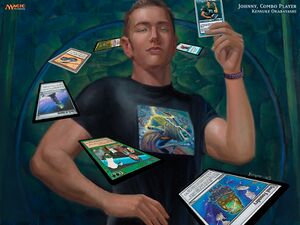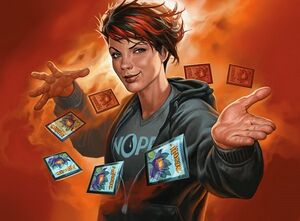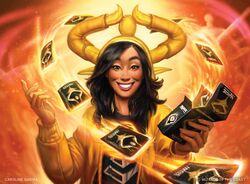Player type
A "player type" refers to the player profiles that Wizards of the Coast has detected. There are two classifications:
- The "psychographic profile" explores why players enjoy the game.
- The "aesthetic profile" explores what players enjoy of the game (why they think it is beautiful).
Psychographic profile
Expansions are designed with cards that appeal to players of all profiles, and Wizards of the Coast categorizes its Magic consumers into three psychographic profiles: Johnny, Timmy, and Spike.[1]
MTG.com columnist and Head Designer Mark Rosewater originally wrote of psychographic profiles:
| “ | After numerous years, we've come to the conclusion that there are three basic types of Magic players. The fancy term for these categories is "psychographic profiles." A psychographic profile separates players into categories based on their psychological make-up. What motivates that player to play? What kind of cards do they like? What kind of things encourages that player to keep on playing?[2] | ” |
Later in August 2015 he wrote:
| “ | The point of a psychographic is to try to understand the psychological motivation behind why a person enjoys what they enjoy. It's not about the "what", but the "why". Now, this can get confusing, because when I talk about design, I focus on the "what".[3] | ” |
In March 2015, Rosewater decided to create female versions to list along with the male versions to convey that these psychographic profiles apply to everyone.[4] Thus, Jenny and Tammy came into use. Rosewater considered Spike to be a nickname that was gender neutral.
In May 2025, Rosewater published a contemporary look at the three Magic psychographics.[5]
Types
Timmy/Tammy

A Timmy or Tammy is characterized by their tendency to use big creatures and cast big spells. Large, exciting plays motivate them. Timmies are most associated with playing for fun, and all kinds of huge creatures, fantastic spells, and mythical enchantments. They are the most social archetype, enjoying the interaction that Magic provides. A stereotypical Timmy/Tammy is usually a younger player with a simple (yet fun for them) deck. They do not care whether they win or lose, but want to have fun playing really big effects.[6][7][8]
Mark Rosewater wrote of Timmy:
| “ | Timmy wants to experience something. Timmy plays Magic because he enjoys the feeling he gets when he plays. What that feeling is will vary from Timmy to Timmy, but what all Timmies have in common is that they enjoy the visceral experience of playing. | ” |
The 'Timmy/Tammy' profile was represented in the Unglued card Timmy, Power Gamer.
Some subgroups of Timmies are:[1]
- Power Gamers love playing big creatures and big spells as they smash their way to victory. They equate power with fun.
- Social Gamers thrive on the social aspect of the game. Their only interest is interacting with their friends. Thus, they tend towards multiplayer variants.
- Diversity Gamers experience all the different deck types and formats. They always try something different because they enjoy constant exploration.
- Adrenaline Gamers enjoy the variance in the game, playing cards and decks that don't have a predictable outcome. They love cards that work differently each time you play them, such as coin flip cards.
- Griefers enjoy making other players not have fun.[9][10]
Timmies see Johnnies as too focused on certain combos and Spikes too bent on winning.
Johnny/Jenny

A Johnny or Jenny is characterized by their tendency to build complex and creative decks. Johnny/Jenny is most commonly known as a 'combo player', and they sometimes choose for elaborate but inefficient win conditions. They like to find interesting combinations of cards that can win the game or give them an advantage. Johnny may be a player who seeks niche cards, or cards widely reputed as bad, and tries to "break" them, exploiting them in ways to give abnormal power and win the game. Johnnies are happiest when their decks work and they win their way; for them, one in many leaves them happy, if that win is on their own terms.[11][12]
Mark Rosewater wrote of Johnny:
| “ | Johnny is the creative gamer to whom Magic is a form of self-expression. Johnny likes to win, but he wants to win with style. It’s very important to Johnny that he win on his own terms. As such, it's important to Johnny that he's using his own deck. Playing Magic is an opportunity for Johnny to show off his creativity. | ” |
The 'Johnny/Jenny' profile was represented in the Unhinged card Johnny, Combo Player.
Some subgroups of Johnnies are:[1]
- Combo Players are fascinated by the interaction of the cards. They find combinations that no one else has. They want to build decks that will impress all who see them.
- Offbeat Designers are driven by ideas. They are proving their ability to find answers for any challenge. What if the deck only had lands? What if the deck never played permanents?
- Deck Artists use deck building as a form of self-expressive art. They build decks that do things like embody the elf culture, for example.
- Uber Johnny thrives on doing the undoable. He proves that what conventional wisdom says can't be done, can be done. To him, no card is too bad to find a use for (even One with Nothing).
Johnnies see Timmies as simplistic and Spikes as uptight and unoriginal.
Spike
- For the creature type, see Spike.

A Spike is characterized by their competitive nature and they play primarily to prove how good they are. Spike will find the best deck in the format, even if it requires copying another innovator's work (see netdecking). Spike's cards are effective, designed to secure a fast and effective victory over opponents. If Spike plays several games and loses only one, but feels they should have won it, they may be malcontent.[13][14]
Mark Rosewater wrote of Spike:
| “ | Spike is the competitive player. Spike plays to win. Spike enjoys winning. To accomplish this, Spike will play whatever the best deck is. Spike will copy decks off the Internet. Spike will borrow other players' decks. To Spike, the thrill of Magic is the adrenaline rush of competition. Spike enjoys the stimulation of outplaying the opponent and the glory of victory. | ” |
The 'Spike' profile was represented in the Unstable card Spike, Tournament Grinder.[15]
Some subgroups of Spikes are:[1]
- Innovators pride themselves on their ability to judge new cards. Their goal is to find the next broken thing. Their dream is to spawn the next dominant deck.
- Tuners try to dominate by fine-tuning the known decks. Known as min/maxers in the role-playing side of gaming.
- Analysts plan on winning not by having the best deck in a vacuum, but by having the deck best suited for any particular environment. They are very focused on the sideboard.
- Nuts & Bolts focuses their energies in perfecting their own gameplay. They try to understand their own internal flaws and work to improve them. They tend to spend more of their time on Limited formats.
Spikes see Timmies as rookies and Johnnies as eccentric and annoying.
Aesthetic profile
Wizards of the Coast categorizes its Magic consumers into two aesthetic profiles: Melvin and Vorthos.[16]
Mark Rosewater wrote of aesthetic profiles:
| “ | The aesthetic profiles represent is how players can find beauty in the game. The label of "Vorthos" or "Mel" simply means you are high enough on the scale that you use the term to self-identify where you find beauty. It is possible to be both a Vorthos and a Mel, or to be neither. Also, being a Vorthos and/or a Mel doesn't necessarily impact your psychographic, because each one can be applied alongside the aesthetic scale.[3] | ” |
In March 2015, Rosewater decided to add female versions of the types to convey that these aesthetic profiles apply to everyone.[4] Rosewater considered Vorthos (as it's made up) to be unisex. In August 2015, Rosewater decided that Mel would be the nickname for both Melvin and Melanie, and he just proposed to only use Mel from that moment.[3]
Types
Mel (Melvin/Melanie)
Mel is the "mechanic player", someone focused on the craft of Design & Development. A Mel is characterized for appreciating cards with delicate and interesting interactions, as well as strong mechanics. A Mel appreciates that there are many different elements that have to come together to make a Magic card function structurally, from the color pie to the mana system to the rules to the templating to the mechanical needs of the set.[3][17]
Examples of cards that a Mel might like include Firemaw Kavu and Stuffy Doll from the Time Spiral expansion and Hangarback Walker from Magic Origins.
Vorthos

Vorthos is the "flavor player", someone focused on the craft of Creative. A Vorthos is characterized by appreciating cards with flavor and creative consistency. The name, the illustration, the card concept, the subtype (if the card has one), the flavor text—each of these helps paint a picture of what exactly the card is representing. A Vorthos evaluates cards based on these components both in isolation and in conjunction. Vorthos was first envisioned by Matt Cavotta.[18][19][20][21]
Examples of cards that a Vorthos might like include Rescue from the Underworld from Theros, Deicide from Journey into Nyx, Crux of Fate from Fate Reforged.
In 2015 Ant Tessitore wrote an article titled "Vorthos 2015" in which he provided an updated view of how one could consider themselves a Vorthos. In the article Ant divided Vorthoses into five categories based on what the individual appreciates about Magic: the Gathering:
- The Gamer appreciates top-down resonance and in-game flavor.
- The Artist appreciates all visual aspects of Magic.
- The Writer appreciates all written copy for Magic.
- The Oracle appreciates real world to fantasy world blending via things like cosplay.
- The Dreamer appreciates anything contributing to the lore of Magic
For the article Ant also commissioned artist Sam Keiser to paint an updated unisex image of Vorthos.
The 'Vorthos' profile was represented in the Unfinity card Vorthos, Steward of Myth. This character could tell you more about herself than any designer could. Myra struck a deal with her that she could only do the Trivia Contest once a month. In exchange, she has a pass to the park.[22] On the days she's not allowed to enter, she still watches from the audience and grumbles angrily about answers she knows.
Trivia
- The Mystery Booster test card Metagamer jokingly introduced a new player type. The Metagamer chooses their cards to counter decks that are popular in the metagame.
Gallery
-
Timmy avatar for Magic: The Gathering Arena
-
Johnny avatar for Magic: The Gathering Arena
-
Spike avatar for Magic: The Gathering Arena
-
Vorthos avatar for Magic: The Gathering Arena
-
An imagining by the Magic Creative Team depicting Vorthos.
-
Sam Keiser's interpretation of "The New Vorthos".
In-game references
Timmy/Tammy
- Represented in:
Johnny/Jenny
- Represented in:
- Quoted or referred to:
Spike
- Represented in:
- Depicted in:
- Quoted or referred to:
Vorthos
- Represented in:
- Depicted in:
- Quoted or referred to:
- Kiddie Coaster (Unfinity, #219f)
- Swinging Ship (Unfinity, #231a)
References
- ↑ a b c d Mark Rosewater (March 20, 2006). "Timmy, Johnny, and Spike Revisited". magicthegathering.com. Wizards of the Coast.
- ↑ Mark Rosewater (March 11, 2002). "Timmy, Johnny, and Spike". magicthegathering.com. Wizards of the Coast. Archived from the original on 2017-05-19.
- ↑ a b c d Mark Rosewater (August 31, 2015). "Vorthos and Mel". magicthegathering.com. Wizards of the Coast.
- ↑ a b Mark Rosewater (March 08, 2015). "The Player Psychographics". Blogatog. Tumblr.
- ↑ Mark Rosewater (May 26, 2025). "The Three Magic Psychographics". magicthegathering.com. Wizards of the Coast.
- ↑ Mark Rosewater (March 09, 2009). "Designing For Timmy". magicthegathering.com. Wizards of the Coast. Archived from the original on 2020-05-30.
- ↑ Kelly Digges (March 10, 2009). "The Timmy Manifesto". magicthegathering.com. Wizards of the Coast. Archived from the original on 2020-05-30.
- ↑ Tom LaPille (March 13, 2009). "The Yang of Timmy". magicthegathering.com. Wizards of the Coast. Archived from the original on 2020-05-31.
- ↑ Mark Rosewater (April 30, 2018). "What's the player psychographic for "enjoys making other players not have fun"?". Blogatog. Tumblr.
- ↑ Mark Rosewater (May 01, 2018). "Why are griefers a subset of Timmy/Tammy?". Blogatog. Tumblr.
- ↑ Mark Rosewater (August 03, 2009). "Designing For Johnny". magicthegathering.com. Wizards of the Coast. Archived from the original on 2020-06-04.
- ↑ Tom LaPille (August 21, 2009). "Johnny Drama". magicthegathering.com. Wizards of the Coast. Archived from the original on 2020-05-31.
- ↑ Mark Rosewater (November 30, 2009). "Designing For Spike". magicthegathering.com. Wizards of the Coast. Archived from the original on 2020-05-30.
- ↑ Tom LaPille (December 11, 2009). "An Open Letter to Spike". magicthegathering.com. Wizards of the Coast. Archived from the original on 2020-05-31.
- ↑ Mark Rosewater (November 16, 2017). "Why is Spike portrayed as a female". Blogatog. Tumblr.
- ↑ Mark Rosewater (May 7, 2007). "Melvin and Vorthos". magicthegathering.com. Wizards of the Coast.
- ↑ Mark Rosewater (May 21, 2007). "Design Language". magicthegathering.com. Wizards of the Coast.
- ↑ Matt Cavotta (August 31, 2005). "Snack Time with Vorthos". magicthegathering.com. Wizards of the Coast. Archived from the original on 2020-05-30.
- ↑ Matt Cavotta (August 31, 2006). "Parlez Vous Vorthos?". magicthegathering.com. Wizards of the Coast. Archived from the original on 2020-05-31.
- ↑ Matt Cavotta (May 24, 2007). "Blood Type V". magicthegathering.com. Wizards of the Coast. Archived from the original on 2020-06-01.
- ↑ Matt Cavotta (September 2, 2015). "A Conversation with Vorthos". magicthegathering.com. Wizards of the Coast. Archived from the original on 2020-06-01.
- ↑ Mark Rosewater (December 9, 2022). "Drive to Work #991 - Names & Favor Text with Ari Zirulnik, Part 2". Tumblr.com.
- ↑ Matt Cavotta (October 19, 2006). "A Word is Worth a Thousand Headaches". magicthegathering.com. Wizards of the Coast. Archived from the original on 2021-04-29.
- ↑ Matt Cavotta (November 23, 2006). "Legends – Who's Got the Sauce?". magicthegathering.com. Wizards of the Coast. Archived from the original on 2020-11-27.

![UnCon Art Contest winning art of Vorthos by Herman Lau[23][24].](https://files.mtg.wiki/thumb/Vorthos_2.jpg/120px-Vorthos_2.jpg)
